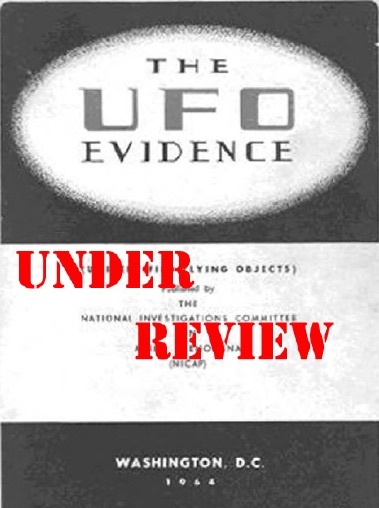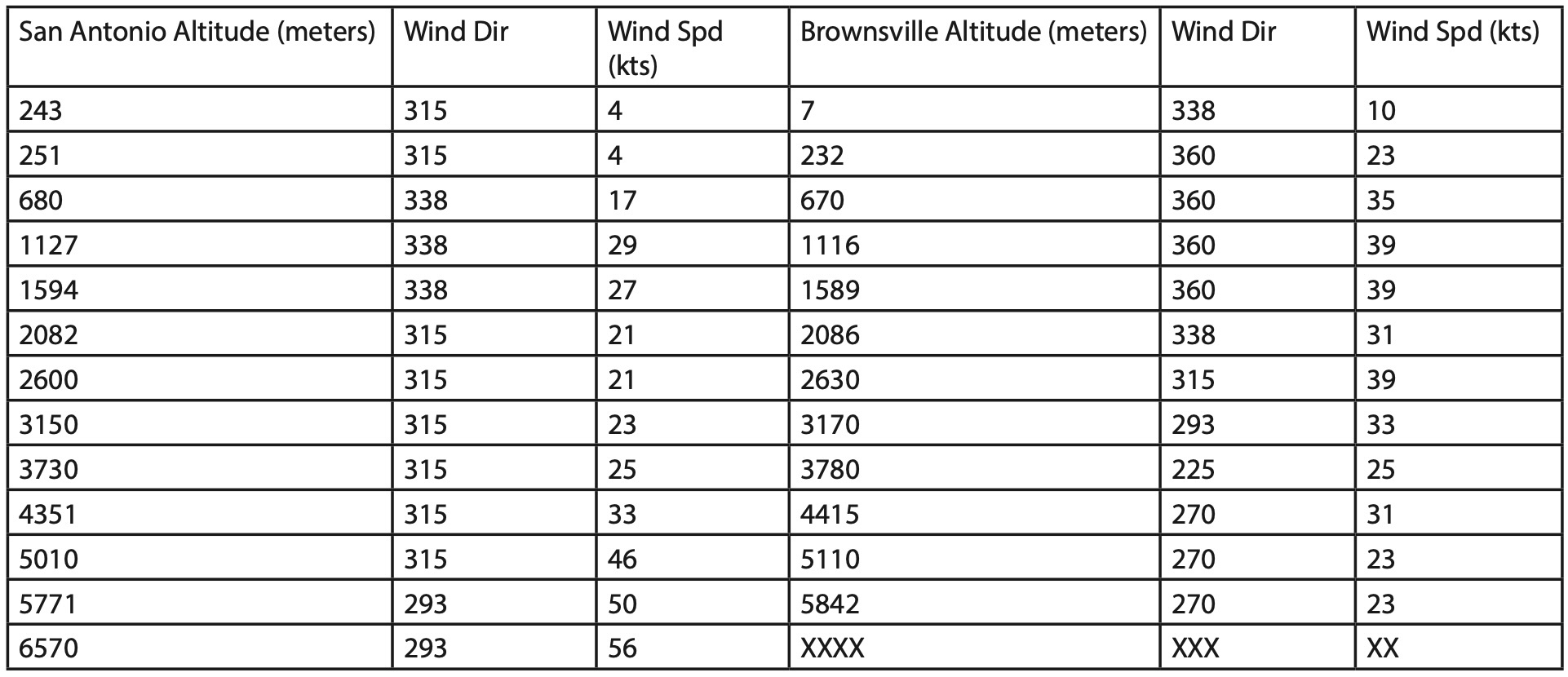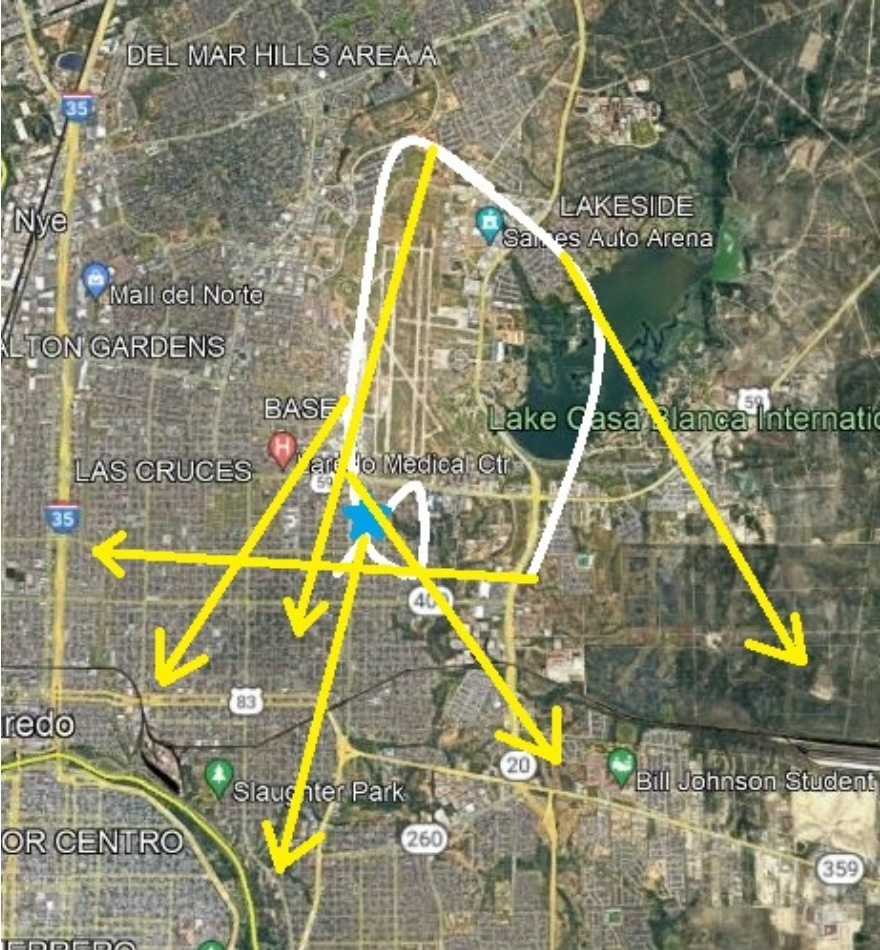12.04.2024

December 4, 1952 - Laredo, Texas
December 4, 1952--Laredo, Texas. USAF F-51 pilot chased glowing white object which made tight
turns, head-on passes at plane. [III].
Section III states:
Glowing object made several passes at plane, maneuvered in tight turns, climbed steeply at high
speed.[35.]2
Footnote 35 states that the information comes from USAF intelligence reports3
Additional Sources
Blue Book has a case file. Loren Gross mentions it in his UFO history.4
On the night of 4 Dec 52 an Air Force pilot was flying locally in a T-28 ·type a/c. It was at this time he noticed a rapidly moving bluish light at approximate traffic altitude (1500’ to 2000’). It was approximately 8 o’clock low to his position, which was about 2 miles SE of the base at 6000’ directly SW of the base traveling on a SE course. The pilot considered the object to be a 4th jet a/c outside the traffic pattern until he noticed the absence of position, passing, and fuselage lights.
The pilot steepened his turn to the left to keep the object in sight. The object continued on a SE course until approximately 6 miles SE of his position which was approximately where he had originally sighted the object. At this time the object rose immediately to the pilot’s altitude of 6000’ and began a wide sweeping counter clockwise orbit of the base. The terrific speed of the object still led the pilot to think it was a jet aircraft until he realized from previous jet experience that the speed should have been considerably dissipated after such a maneuver. At a position approximately 3 miles N of the air field in the object’s orbit, it immediately descended to approximately 19,000 ... (?) ...1500 to 200’ again and continued its orbit to the left around the city of Laredo, Texas, until it reached approximately the center of the
business district, at which time the object made a very rapid flitting ascent due S to approximately 15,000’. The rate of climb was terrific. At this point, the object was approximately 6 to 8 miles SW of the pilot’s position (which was directly over the ramp on a S heading). The object then turned Eastward and immediately descended to the pilot’s altitude of 6,000’ again and proceeded Eastward until approximately 6 miles SE of the base again and it seemed to stop as if it were hovering, going straight away or coming straight toward the pilot’s aircraft.
At this the pilot added full power and proceeded directly SE toward the object. The pilot’s intentions were merely curiosity. Approximately 2 seconds after this action was taken by the pilot, the object appeared to close at a terrific rate in a head-on approach. At approximately 100 yards in front of the pilot’s a/c the object seemed to waver slightly in a vertical plane as if determining on which side of his aircraft to pass. The object passed very closely off the left wing of the a/c within 50 yards distance and the pilot noted a blurred reddish-blueish haze of undetermined size and shape but definitely no larger than his a/c. This action happened so rapidly that the pilot was unable to take any evasive action. Immediately after the object passed, the pilot broke sharply to the left in order to keep the object in sight. The
object rapidly made a flitting ascent again to approximately 15,000’ and circled to the left and began to descent as if positioning itself for another pass on the pilot’s a/c. At this point, out of sheer fright, the pilot turned off all his running lights and spiraled steeply to the left, keeping the object in sight and leveled off at 1500’. At this time the object seemed to level off from its circling descent towards the pilot’s a/c, turned sharply to the right on a S heading and made another rapid flitting ascent into the atmosphere until out of sight. The object was observed by the pilot for approximately 7 minutes and the exact time of the head-on-pass was 2053. The object has been referred to
as an ‘object ‘ because it was identifiable only by the small, flickering blueish light by which the observer was able to track its flight path, the size of the light was described by the observer as approximately1/2 the size of the glow emitted by normal position light on a T-33 type aircraft. Its speed was estimated to be in excess of 500 MPH and its maneuvers, which consisted mainly of rapid flitting ascents and descents, were unusually outstanding, because they were certainly not conventional. The observer parked his a/c on the Laredo AB ramp at exactly 2105 and shortly thereafter reported the incident to the proper authority.
“ATIC COMMENT: ATIC believes that it was an a/c and that the maneuvers were exaggerated.” 166 Note 166 comes from an Air Intelligence report in the Blue Book file.
The Blue Book file is consistent with this description.5 Some details that are not clear are:
•
The pilot was flying around the base in a counter-clockwise pattern when he saw the object.
•
The sighting started at approximately 2045-2048 depending on which document you examine in the file.
•
There is a mentioned plot of the aircraft and the object in the file but I could not locate such a plot.
Analysis
There is a potential astronomical explanation for the sighting. Venus was had set in the SW just before the time listed for the sighting. It is important to note that the pilot’s first sighting was towards the west. That being said, the motion of the object during the sighting tends to rule out astronomical object. Venus may have played an initial role that drew the pilot’s attention towards that direction and he later picked up another source that explains the rest of the event.
The Blue Book file revealed that a lighted weather balloon had been released at 2053 CST (0253Z) from the Laredo AFB.6 Observers stated they did not see an aircraft near the balloon. While we did not get the data from that balloon, it did state that “low altitude” winds were from the northwest at “low velocity”. The teletype message states the winds at the pilots level were from 15 degrees at 25 knots. There is some historic radiosonde data from Brownsville 0300Z on 5 December and San Antonio at 0400Z on 5 December.7

These values are consistent with the statements made about the winds in Laredo that night in the Blue Book file. Most of the winds were from the NW or North, which means the balloon that was released would have been traveling to the SE or South at a speed of around 20-30 knots.

The missing track diagram means we don’t have all the data. However, one can create a plot based on the description of events. I performed this to the right. The White track is the aircraft. The Blue Star is the approximate location of the “intercept”. The yellow lines are sight lines reported by the pilot. All of these tracks and sightlines are approximate values. It is interesting to note that the pilot always observed the object towards the south of the base.
Initially, the pilot was SE of the base and observed the object towards the west. As the pilot continued his counterclockwise orbit and moved to the north side of the base, he noticed the object was also orbiting the base in a counter-clockwise motion. The object shifted from the west towards the southeast as the pilot moved in a north-northwesterly direction. When the pilot began flying south, the object was again, south of the base. At this point he attempted the intercept. He passed very close to the object and then began, a tight counter-clockwise turn. The UFO appeared to perform the same maneuver and then suddenly went south and rapidly rose into the sky.
Some of the reported positions of the object seemed to be poor estimates made by the pilot. The pilot was orbiting counterclockwise in a 2-3 mile radius around the base. When an aircraft is moving in a circle, a stationary or slowly moving target will appear to be also moving in a circle in the same direction against the background due to parallax. The same could be said about the changing altitude of the object. The object was performing yo-yo like maneuvers in altitude. The aircraft banking and changing altitude could make an object appear lower or higher when compared to background objects.
One point that I think is also important is that, In all of these maneuvers reported by the pilot, no other pilots in the landing pattern or tower personnel/weather observers/ground personnel noticed this object. While some might suggest that the object was not a prominent object, one must remember, based on the pilot’s estimates, it could be seen from miles away.
Conclusion
There is the possibility that what was seen was a balloon. Venus might have played a role in the initial sighting but it could not have been involved in the rest of what was reported. The aerobatics and speed of the object can be mostly attributed to the observing aircraft moving about and the pilots perception of the motion being not from his aircraft but of the observed object. A balloon was released around the time of the incident. There is a few minute time discrepancy but this could have been due to reporting error. There is also the comment that the weather personnel did not see the pilot approach the balloon. It could have been the pilot was not as close as he guessed or they may have missed this brief interaction, which probably lasted less than one minute.
One cannot be sure but the characteristics of the event are that of a balloon. We can’t prove that the balloon was the source but it is possible. This should be classified as a possible balloon and removed from “best evidence” and Weinstein catalog.
Quelle: SUNlite 6/2023
